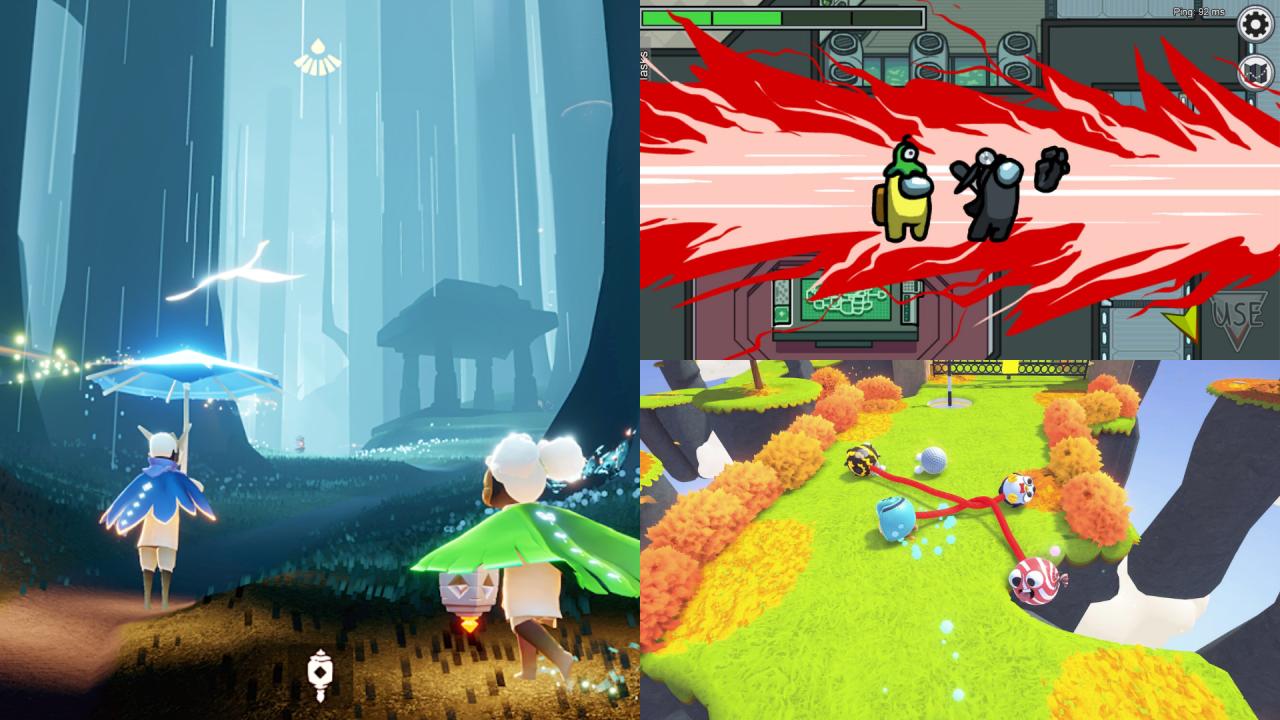Free games have taken the gaming world by storm, offering players an array of options without the need to spend a dime. From immersive MMORPGs to adrenaline-pumping battle royales and captivating mobile puzzle games, the variety is vast and enticing. The landscape of free games has evolved significantly over the years, reflecting changes in technology and player preferences, making it an exciting space for both seasoned and new gamers alike.
This exploration delves into the popular genres of free games, highlights the top trending titles, and examines how different platforms—from PCs to consoles and mobile devices—facilitate access to these games. Additionally, we will unpack the monetization strategies used by developers that allow free games to remain accessible while generating revenue.
Popular Types of Free Games

The gaming landscape has undergone significant transformation over the years, especially with the rise of free-to-play titles. These games offer an accessible entry point for millions of players, eliminating barriers to participation while still providing engaging and immersive experiences. This discussion focuses on the various genres of free games, highlighting their unique characteristics and popularity.
Genres of Free Games
Free games span a range of genres that cater to diverse player preferences. MMORPGs (Massively Multiplayer Online Role-Playing Games) allow players to immerse themselves in vast virtual worlds, often featuring complex storylines and character progression. Battle royale games emphasize competitive play, where participants fight to be the last one standing in an ever-shrinking environment. Mobile puzzle games engage players with challenging gameplay mechanics that are easy to pick up and play, making them perfect for casual gaming sessions.
Top Trending Free Games
The following list features ten of the most popular free games currently captivating audiences, each offering unique features that contribute to their success:
- Fortnite – A battle royale game known for its vibrant graphics and innovative building mechanics, captivating a broad player base with constant updates and live events.
- League of Legends – This MMORPG offers a strategic multiplayer experience set in the fantasy world of Runeterra, engaging players with its dynamic champions and competitive ranking system.
- Call of Duty: Warzone – An immersive battle royale that integrates military strategy and fast-paced action, featuring a distinctive Gulag mechanic that allows eliminated players a second chance to re-enter the game.
- Apex Legends – A hero-based battle royale with unique character abilities, this game stands out for its team-oriented gameplay and fluid movement mechanics.
- Genshin Impact – A visually stunning open-world RPG that combines exploration and action combat, offering players a rich narrative and expansive world to discover.
- Among Us – This social deduction game thrives on teamwork and deception, where players work together to complete tasks while trying to identify impostors among them.
- Valorant – A tactical first-person shooter that combines character abilities with traditional FPS mechanics, fostering an engaging competitive scene.
- Fall Guys: Ultimate Knockout – Featuring colorful, whimsical mini-games, this battle royale focuses on fun and light-hearted competition, appealing to casual gamers.
- Roblox – A platform for user-generated games, Roblox allows players to create, share, and play games created by others, encouraging creativity and community interaction.
- Destiny 2 – An online multiplayer FPS that offers a blend of PvE and PvP content, featuring a captivating lore and a vibrant world, continuously updated with new expansions.
Evolution of Free Games
The evolution of free games has been marked by significant milestones, transitioning from simplistic browser-based titles to complex, high-quality experiences that rival traditional paid games. The introduction of microtransactions allowed developers to monetize games without initial costs, leading to the widespread popularization of free-to-play models. Over time, games have adopted more sophisticated mechanics, immersive graphics, and compelling narratives, creating a rich gaming environment that appeals to a wider audience.
“The evolution of free games has redefined accessibility, allowing players from around the globe to engage in immersive experiences without financial barriers.”
Platforms for Accessing Free Games

Accessing free games has never been easier, thanks to a variety of platforms available today. From personal computers to consoles and mobile devices, each platform offers a unique way to enjoy free gaming experiences. Understanding these platforms not only helps players choose where to game but also provides insights into how to effectively download and install these games.
Different platforms provide varying user experiences, affecting gameplay accessibility and performance. Here’s a comparison of three major platforms: PC, consoles, and mobile devices, focusing on their strengths, weaknesses, and the processes involved in accessing free games on each.
PC Gaming Platforms, Free games
The PC remains one of the most versatile platforms for accessing free games. Popular platforms like Steam, Epic Games Store, and Origin frequently offer free titles. The user experience is often enhanced by the ability to customize settings, install mods, and connect with a broad community of players.
To download and install free games on a PC, follow these steps:
1. Choose a Platform: Select a digital distribution platform (e.g., Steam, Epic Games).
2. Create an Account: Register for an account if you don’t have one.
3. Download the Client: Install the platform’s client software on your PC.
4. Browse Free Games: Navigate to the free games section.
5. Download the Game: Click on the game you wish to download, then select ‘Download’.
6. Install the Game: Once downloaded, follow the prompts to install the game.
The PC gaming platform often delivers superior graphics and performance, allowing for more immersive gameplay. However, it does require a decent hardware setup to optimize the experience fully.
Console Gaming Platforms
Consoles like PlayStation, Xbox, and Nintendo Switch offer a different, more streamlined gaming experience. Each console has its own online service, such as PlayStation Plus and Xbox Live, which often includes free games as part of the subscription service. Some free-to-play titles are also available directly.
The process to access free games on consoles includes:
1. Navigate to the Store: Open the console’s digital store (e.g., PlayStation Store).
2. Create or Log In to an Account: Ensure you have a valid account to access content.
3. Search for Free Games: Look for categories or sections labeled ‘Free’ or ‘Free-to-Play’.
4. Select and Download: Choose the game you want and confirm the download.
5. Install and Play: The game should install automatically, allowing you to start playing right away.
Console gaming typically offers a more user-friendly experience with simplified controls and social features, although it may lack the customization options found in PC gaming.
Mobile Gaming Platforms
Mobile devices have surged in popularity, providing a plethora of free game options through platforms like Android’s Google Play Store and Apple’s App Store. The accessibility of mobile gaming allows players to enjoy games on the go, although it often comes with in-app purchase options.
To download free games on mobile devices, you can follow these steps:
1. Open the App Store: Access the Google Play Store or Apple App Store on your device.
2. Create or Log In to an Account: Ensure that you have an account set up.
3. Search for Free Games: Use the search feature or browse through categories for free apps.
4. Select and Download: Tap on the game you wish to download and select ‘Install’.
5. Launch the Game: Once installed, the game will appear on your home screen for easy access.
Mobile gaming is convenient, providing quick access to games, although the experience may vary greatly based on device specifications. Performance can be limited compared to PCs and consoles, especially for graphics-intensive games.
“Each gaming platform offers unique advantages, influencing gameplay style, accessibility, and community engagement.”
Monetization Strategies in Free Games

Free games have become a prominent fixture in the gaming industry, allowing players to access exciting content without an initial cost. However, developers need effective monetization strategies to sustain their projects and generate revenue. This section explores various models used by developers, including in-app purchases and advertisements, while also weighing the pros and cons of free-to-play formats for both players and developers.
Monetization strategies in free games primarily focus on generating revenue while maintaining player engagement. The most common methods include in-app purchases, where players can buy virtual items or enhancements, and advertisements that generate income through ad placements during gameplay. These methods enable developers to offer their games for free while still earning a profit.
Monetization Models in Free Games
Understanding the various monetization models is crucial for both developers and players. Here are the key strategies commonly employed in free games:
- In-App Purchases (IAP): Players can buy virtual goods, such as character skins, power-ups, or extra lives, which enhance their gaming experience.
- Advertisements: Developers display ads within the game, earning revenue based on impressions, clicks, or video views. This model can be integrated as banner ads, interstitials, or rewarded videos.
- Freemium Model: Basic gameplay is free, but advanced features or content require payment. This model encourages players to try the game before committing financially.
- Season Passes: Players pay for access to exclusive content and challenges for a limited time, driving engagement and additional revenue.
Each model has unique advantages and challenges, influencing player experience and developer revenue.
Pros and Cons of Free-to-Play Models
The free-to-play model has become incredibly popular, but it comes with both benefits and downsides for players and developers.
Players may enjoy the following advantages:
- No Initial Cost: Players can access games without any upfront payment, allowing them to explore various titles without financial commitment.
- Flexible Spending: Players can spend as much or as little as they want, choosing to invest only in features that enhance their experience.
However, there are notable drawbacks:
- Pay-to-Win Dynamics: Players who spend money may gain significant advantages, leading to an uneven playing field.
- Ads Disruption: Frequent advertisements can interrupt gameplay, causing frustration for players who prefer uninterrupted experiences.
For developers, the free-to-play model offers:
- Large Player Base: Providing free access attracts a wider audience, increasing potential revenue from ads and IAP.
- Recurring Revenue Streams: In-app purchases and ad revenue can create ongoing income from engaged players.
Conversely, developers face challenges:
- Balancing Monetization and Player Experience: Developers must find the right balance between generating revenue and keeping players satisfied to avoid churn.
- Market Saturation: The abundance of free games can lead to fierce competition, making it difficult for new titles to stand out.
Top Free Games and Their Monetization Strategies
To illustrate the diverse monetization strategies in free games, here are some top titles along with their respective models:
| Game Title | Monetization Strategy |
|---|---|
| Fortnite | In-App Purchases (Skins, Battle Pass) |
| Among Us | In-App Purchases (Cosmetics) |
| Genshin Impact | Gacha System (Character Pulls), In-App Purchases |
| Clash of Clans | In-App Purchases (Resources) |
| Call of Duty: Mobile | In-App Purchases, Battle Pass, Advertisements |
This table highlights how top games leverage different monetization strategies, providing insights into the industry’s revenue generation landscape while catering to player preferences.
If you’re in the mood for some delicious pizza, you should definitely check out papa’s pizzeria. This local gem serves up a variety of mouthwatering pizzas that cater to all tastes. Whether you’re a fan of classic pepperoni or looking to try something unique, their menu has something for everyone. Don’t miss out on the chance to enjoy a slice at this cozy spot!
If you’re in the mood for some delicious slices, you should definitely check out papa’s pizzeria. This spot has been serving up mouthwatering pizzas that cater to every taste. Whether you prefer classic Margherita or something more adventurous, their menu has something for everyone. Plus, the cozy atmosphere makes it a great place to hang out with friends or family.


